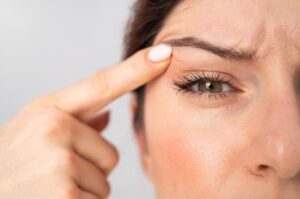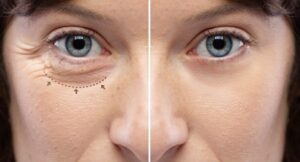Quick Facts
- Procedure: Outpatient
- Anesthesia: General or local anesthesia with sedation
- Duration of Procedure: About two hours
- Initial Recovery Phase: About one week
- Results: Apparent immediately, but continue to improve as post-op symptoms subside
Do other people constantly remark that you look depressed or exhausted even though you are a happy, well-rested person? If so, their mischaracterization could be due to the appearance of drooping eyelids, which often make a person seem concerned or tired. Thankfully, Dr. Sean Maguire offers individuals in Louisville eyelid surgery, or blepharoplasty, to provide a refreshed look throughout the eyes. To view Dr. Maguire’s patients’ tummy tuck results, visit our eyelid surgery gallery.
Why Does Eyelid Surgery Become Necessary?
 Over time, the skin loses its elasticity and begins to sag. Muscle tone degenerates while fat is displaced. These developments often affect the eyes, leading to heavy, drooping upper eyelids and / or sagging, bulging lower eyelids.
Over time, the skin loses its elasticity and begins to sag. Muscle tone degenerates while fat is displaced. These developments often affect the eyes, leading to heavy, drooping upper eyelids and / or sagging, bulging lower eyelids.
If the upper eyelids sag enough, they can impede the line of sight. When lower eyelids droop, they can cause the look of dark under-eye “bags.” The overall effect is a tired, sad appearance throughout the eyes.
With blepharoplasty, Dr. Maguire can improve the look of sagging upper and / or lower eyelids. He can also create a distinct crease in the upper eyelids, a trait that individuals of certain ethnic backgrounds, such as those of Asian heritage, often lack.
What Happens During the Eyelid Surgery Procedure?
Blepharoplasty is an outpatient surgery, performed with either general anesthesia or local anesthesia and sedation. The duration of the operation is about two hours, depending on whether Dr. Maguire treats both sets of eyelids or just the upper or lower lids.
If Dr. Maguire is addressing both sets of eyelids, he starts with the upper ones. He places an incision in the natural fold of the upper eyelid, where it is least noticeable. He excises the surplus skin as well as any displaced fat. The surgeon then tightens the underlying tissues, as needed, before closing the incision with removable stitches.
The plastic surgeon treats the lower eyelids next, placing an incision either inside the lower eyelid or just beneath the lower lash line. He repeats the process, excising surplus skin and removing unwanted fat from the area before tightening the underlying tissues, if necessary. Dr. Maguire closes the incisions, using dissolvable stitches for incisions placed inside the lower eyelid or removable stitches for incisions placed underneath the lower eyelashes.
What Is the Blepharoplasty Recovery Period Like?
Following eyelid surgery, you should arrange to take one to two weeks off from work or your everyday routine. During this time, get plenty of rest and avoid strenuous activity. You can go for walks; just avoid activities that might make your eyes throb.
The treatment area might be swollen, bruised and tender, but these are normal symptoms that will improve over time. Taking oral pain medication as directed by Dr. Maguire and gently placing icepacks over your eyes will help relieve any discomfort.
 Your symptoms should greatly improve within about one week, but you might want to wait two weeks to make sure that all visible signs of your procedure have resolved. In the meantime, you can cover up residual symptoms with makeup, but take care not to apply makeup directly on the incision sites.
Your symptoms should greatly improve within about one week, but you might want to wait two weeks to make sure that all visible signs of your procedure have resolved. In the meantime, you can cover up residual symptoms with makeup, but take care not to apply makeup directly on the incision sites.
Eyelid Lift FAQs
Is there a “Best Age” to have an Eyelid Lift?
 Most people seeking an eyelid lift are tired of looking tired or angry due to drooping upper eyelids and sagging lower eyelids. This is a common and natural part of aging as fat pockets shrink and migrate, and the skin loses collagen and elasticity, causing sagging skin and sinking fat and leading to drooping, puffy eyelids.
Most people seeking an eyelid lift are tired of looking tired or angry due to drooping upper eyelids and sagging lower eyelids. This is a common and natural part of aging as fat pockets shrink and migrate, and the skin loses collagen and elasticity, causing sagging skin and sinking fat and leading to drooping, puffy eyelids.
While there is no perfect age for blepharoplasty, most patients are over 40. Many people have an eyelid lift in their 50s and 60s to address eyelid ptosis (drooping) for cosmetic purposes and, in some cases, medical reasons.
Some people in their 20s and 30s may wish to have blepharoplasty to address a hooded eyelid appearance or create an upper eyelid (a popular procedure among individuals of Asian descent).
Will I Have Scarring After Eyelid Surgery?
Dr. Maguire aims to conceal the incisions for upper blepharoplasty within the natural eyelid crease. Lower blepharoplasty incisions may be hidden on the inside of the eyelid or made along the eyelash line. Our plastic surgeon will work to minimize visible scarring so you can enjoy a well-rested appearance.
The delicate, thin eyelid skin heals quicker than other areas. Any resulting scars will likely only be noticeable to you and loved ones who know you’ve had eyelid surgery when your eyes are closed. Women may easily conceal eyelid lift scars with makeup.
Is an Upper Blepharoplasty or Brow Lift Right for Me?
An upper blepharoplasty focuses on the upper eyelids, removing excess tissues and repositioning fat and muscles to eliminate drooping and puffiness. A brow lift elevates the eyebrows and reduces the hooded effect on the upper eyelids. This procedure is also called a forehead lift as it reduces horizontal forehead lines and improves the vertical creases between the brows (frown lines).
If you are mainly concerned with drooping upper eyelids and excess eyelid skin, upper blepharoplasty is likely the best option. A brow lift may be the right choice if you have moderately or severely drooping brows and lines and wrinkles in the upper face.
Dr. Maguire can evaluate the appearance and musculature of your eyelids and upper face during your consultation. He will customize your procedure to address your cosmetic concerns.
Can I Combine Other Facial Plastic Surgeries with My Blepharoplasty?
Yes, several facial plastic surgeries may be combined with eyelid surgery. A facelift is often performed at the same time as blepharoplasty. The upper eyelid lift may be combined with a brow lift to rejuvenate the upper face, and Dr. Maguire may also combine upper and lower blepharoplasty if you have ptosis and other concerns with both eyelids.
How Long Will My Blepharoplasty Results Last?
 Lower blepharoplasty offers longer-lasting results than upper blepharoplasty. The longevity of upper eyelid surgery depends on your skin quality and age, but, typically, results last up to seven years. An upper blepharoplasty won’t stop the aging process, and the delicate nature of eyelid skin makes this area age before other parts of the face. Lower eyelid lift results are virtually permanent, rarely requiring a second surgery.
Lower blepharoplasty offers longer-lasting results than upper blepharoplasty. The longevity of upper eyelid surgery depends on your skin quality and age, but, typically, results last up to seven years. An upper blepharoplasty won’t stop the aging process, and the delicate nature of eyelid skin makes this area age before other parts of the face. Lower eyelid lift results are virtually permanent, rarely requiring a second surgery.
Will Insurance Cover My Upper Eyelid Surgery?
If eyelid ptosis interferes with your vision and impacts your ability to perform daily tasks, your insurance provider may cover a portion or all of the cost. However, cosmetic blepharoplasty to improve eyelid drooping is not covered by insurance.
How Much Does Eyelid Surgery Cost?
The cost of your eyelid surgery depends on the type of lift and whether you are combining blepharoplasty with another face procedure. Physician’s Center for Beauty will provide a price quote after your consultation, including surgical facility expenses, our plastic surgeon’s fees, anesthesiologist costs, post-operative care and follow-up appointments. Our Louisville office may offer financing options to pay for your blepharoplasty.
Achieve a Happier, Well-Rested Look
Blepharoplasty can help you look happier and well rested overall. To schedule a personal consultation with Dr. Maguire to learn more about eyelid surgery, contact Physician’s Center for Beauty.






